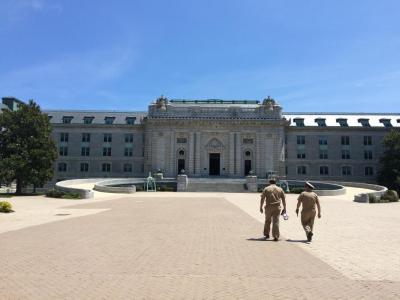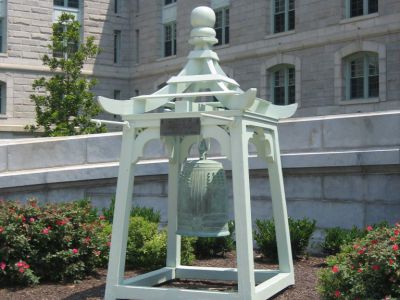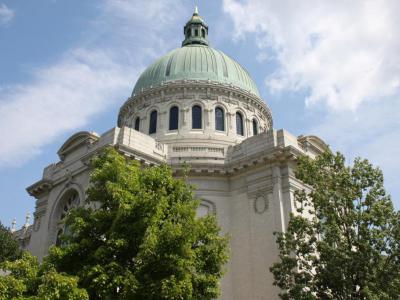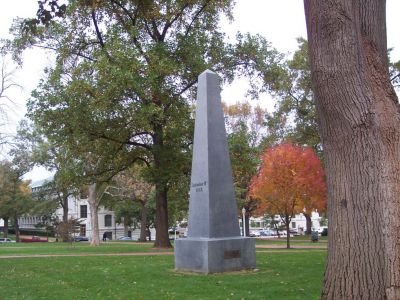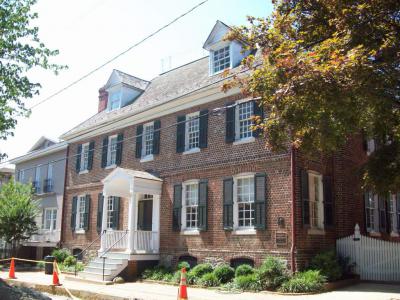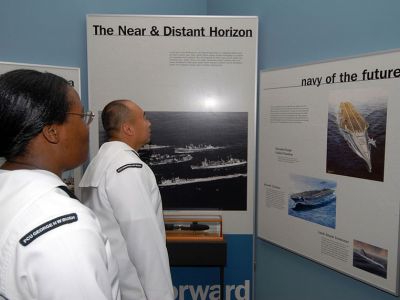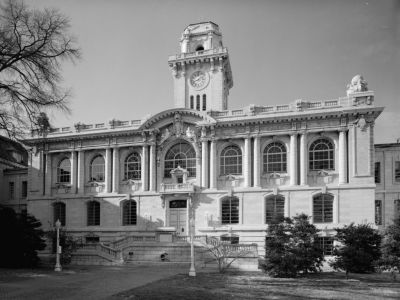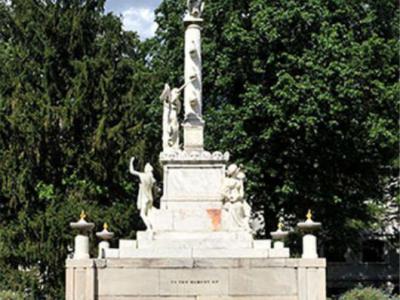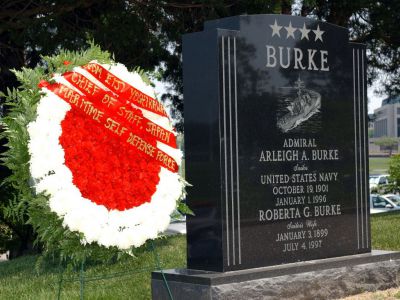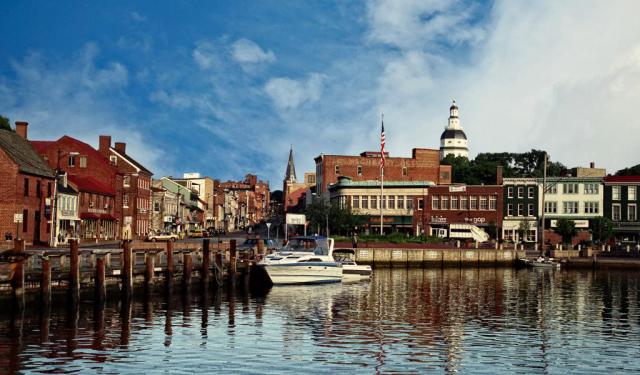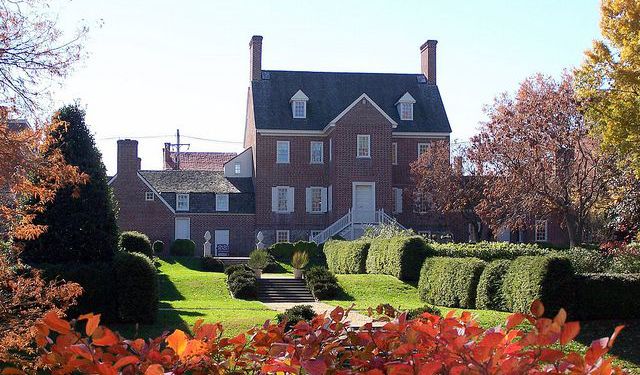Naval Academy Campus Walking Tour (Self Guided), Annapolis
Established in 1845 under George Bancroft, the US Naval Academy in Annapolis is the city's most prominent complex. Situated right at the confluence of Severn River and Chesapeake Bay, this prestigious institution, where future naval officers receive their education and training, has on its campus some truly magnificent structures.
At the heart of it stands Bancroft Hall, the largest dormitory in the United States (if not the whole world!) and a symbol of the Academy's unity and camaraderie. Nearby, the Temple Bell rings out, marking important events and gatherings within the campus community. The Naval Academy Chapel is a solemn place of worship, providing spiritual guidance to the midshipmen.
One of the most iconic landmarks on campus is the Herndon Monument, where each year, plebes (first-year students) work together to climb and replace a plebe's hat with a midshipman's hat, symbolizing their transition into the Brigade of Midshipmen. The Peggy Stewart House serves as a reminder of the Academy's historical ties, notably to the burning of the ship bearing the same name.
For those interested in naval history and artifacts, the Naval Academy Museum offers a fascinating glimpse into the past, displaying a collection of naval memorabilia and artifacts. Mahan Hall hosts various academic and cultural events, housing historical artifacts while also serving as the venue for the midshipman theatrical company.
The Tripoli Monument commemorates the fallen heroes of the First Barbary War in the early 1800s, highlighting the Academy's commitment to honor and remember those who have served. The Naval Academy Observatory provides opportunities for students to explore the wonders of the universe and engage in astronomical research.
Finally, the Naval Academy Cemetery serves as a final resting place for those who have dedicated their lives in service to their country, offering a peaceful and reverent setting for reflection and remembrance.
A visit to the United States Naval Academy Campus in Annapolis is a chance to learn about its storied past and witness firsthand the commitment to excellence and service that defines this esteemed institution. Our self-guided walk is designed to help you with that.
At the heart of it stands Bancroft Hall, the largest dormitory in the United States (if not the whole world!) and a symbol of the Academy's unity and camaraderie. Nearby, the Temple Bell rings out, marking important events and gatherings within the campus community. The Naval Academy Chapel is a solemn place of worship, providing spiritual guidance to the midshipmen.
One of the most iconic landmarks on campus is the Herndon Monument, where each year, plebes (first-year students) work together to climb and replace a plebe's hat with a midshipman's hat, symbolizing their transition into the Brigade of Midshipmen. The Peggy Stewart House serves as a reminder of the Academy's historical ties, notably to the burning of the ship bearing the same name.
For those interested in naval history and artifacts, the Naval Academy Museum offers a fascinating glimpse into the past, displaying a collection of naval memorabilia and artifacts. Mahan Hall hosts various academic and cultural events, housing historical artifacts while also serving as the venue for the midshipman theatrical company.
The Tripoli Monument commemorates the fallen heroes of the First Barbary War in the early 1800s, highlighting the Academy's commitment to honor and remember those who have served. The Naval Academy Observatory provides opportunities for students to explore the wonders of the universe and engage in astronomical research.
Finally, the Naval Academy Cemetery serves as a final resting place for those who have dedicated their lives in service to their country, offering a peaceful and reverent setting for reflection and remembrance.
A visit to the United States Naval Academy Campus in Annapolis is a chance to learn about its storied past and witness firsthand the commitment to excellence and service that defines this esteemed institution. Our self-guided walk is designed to help you with that.
How it works: Download the app "GPSmyCity: Walks in 1K+ Cities" from Apple App Store or Google Play Store to your mobile phone or tablet. The app turns your mobile device into a personal tour guide and its built-in GPS navigation functions guide you from one tour stop to next. The app works offline, so no data plan is needed when traveling abroad.
Naval Academy Campus Walking Tour Map
Guide Name: Naval Academy Campus Walking Tour
Guide Location: USA » Annapolis (See other walking tours in Annapolis)
Guide Type: Self-guided Walking Tour (Sightseeing)
# of Attractions: 10
Tour Duration: 1 Hour(s)
Travel Distance: 1.7 Km or 1.1 Miles
Author: AudreyB
Sight(s) Featured in This Guide:
Guide Location: USA » Annapolis (See other walking tours in Annapolis)
Guide Type: Self-guided Walking Tour (Sightseeing)
# of Attractions: 10
Tour Duration: 1 Hour(s)
Travel Distance: 1.7 Km or 1.1 Miles
Author: AudreyB
Sight(s) Featured in This Guide:
- Bancroft Hall
- Temple Bell
- Naval Academy Chapel
- Herndon Monument
- Peggy Stewart House
- Naval Academy Museum
- Mahan Hall
- Tripoli Monument
- Naval Academy Observatory
- Naval Academy Cemetery
1) Bancroft Hall
Bancroft Hall at the United States Naval Academy is the largest single dormitory in the world. Named after former Secretary of the Navy, George Bancroft, the hall is home for the entire brigade of 4,000 midshipmen, and contains some 1,700 rooms, 4.8 miles of corridors, and 33 acres of floor space, plus all the basic facilities that midshipmen need for daily living.
Bancroft Hall was designed by Beaux-Arts architect, Ernest Flagg, and its central rotunda and first two wings were built in 1901–06. Over the intervening years it has been expanded to encompass eight wings of five stories, each numbered 0-4. In addition to the midshipmen rooms, Bancroft Hall houses offices for the Commandant of Midshipmen, six battalion officers, six battalion chaplains, 30 company officers and their senior enlisted leaders, a barbershop, bank, travel office, a small restaurant known as "Steerage," textbook store, general store, laundromat, uniform store, cobbler shop, the USNA Band, the USNA branch of the United States Postal Service, a gymnasium, spaces for extracurricular activities, and full medical & dental clinics, as well as small optometry and orthopedics clinics. There are rooms in Bancroft dedicated to each Academy graduate Medal of Honor recipient in the Navy or Marine Corps.
Bancroft Hall was designed by Beaux-Arts architect, Ernest Flagg, and its central rotunda and first two wings were built in 1901–06. Over the intervening years it has been expanded to encompass eight wings of five stories, each numbered 0-4. In addition to the midshipmen rooms, Bancroft Hall houses offices for the Commandant of Midshipmen, six battalion officers, six battalion chaplains, 30 company officers and their senior enlisted leaders, a barbershop, bank, travel office, a small restaurant known as "Steerage," textbook store, general store, laundromat, uniform store, cobbler shop, the USNA Band, the USNA branch of the United States Postal Service, a gymnasium, spaces for extracurricular activities, and full medical & dental clinics, as well as small optometry and orthopedics clinics. There are rooms in Bancroft dedicated to each Academy graduate Medal of Honor recipient in the Navy or Marine Corps.
Sight description based on Wikipedia.
2) Temple Bell
Installed in a specially constructed belfry, to the left of Bancroft's Hall entrance to the U.S. Naval Academy in Annapolis, is a large bronze replica of the Temple Bell that United States Commodore, Matthew Perry, brought back from Japan following his mission there in 1855. This bell was among the items “given” to Commodore Perry, upon his explicit request, by the Regent of the Ryukyu Kingdom during the fourth and final exchange of gifts between the U.S. and the Kingdom on 11 July 1854. Attesting to this is a commemorative plaque with the inscription "Replica of the Temple Bell presented in 1854 to Commodore M. C. Perry, USN by the Regent of the Lew Chew Islands (Okinawa)".
Otherwise known as the Gokoku-ji, the original bell, cast in 1456, for many years remained at the Academy, presented here in 1859, by the Commodore’s wife, after his death, according to his wish. The inscriptions on this bell read: “Daiku Emon-no-jo Fujiwara Kunimitsu” (The [Japanese] Imperial Official Master Metalworker, Fujiwara Kunimitsu); “Keitai shichi-sai” (the seventh year of the Ming dynasty Ching t’ai period ), along with a lengthy votive epitaph. In translation it says in part: “May the sound of this bell shatter illusory dreams, perfect the souls of mankind, and enable the King and his subjects to live so virtuously that barbarians will find no occasion to invade the kingdom.”
Both, the original bell and its replica have played a role in the U.S. Naval Academy traditions, ringing to celebrate each time the Navy defeated the US Army in an annual football game between the teams of USMA and USNA.
On 22 July 1987 the original Gokoku-ji bell was returned to Okinawa, Japan, courtesy of retired Marine Maj. Gen. James L. Day, who successfully led the return negotiations. It is now displayed in the Okinawa Prefectural Museum at Naha.
Otherwise known as the Gokoku-ji, the original bell, cast in 1456, for many years remained at the Academy, presented here in 1859, by the Commodore’s wife, after his death, according to his wish. The inscriptions on this bell read: “Daiku Emon-no-jo Fujiwara Kunimitsu” (The [Japanese] Imperial Official Master Metalworker, Fujiwara Kunimitsu); “Keitai shichi-sai” (the seventh year of the Ming dynasty Ching t’ai period ), along with a lengthy votive epitaph. In translation it says in part: “May the sound of this bell shatter illusory dreams, perfect the souls of mankind, and enable the King and his subjects to live so virtuously that barbarians will find no occasion to invade the kingdom.”
Both, the original bell and its replica have played a role in the U.S. Naval Academy traditions, ringing to celebrate each time the Navy defeated the US Army in an annual football game between the teams of USMA and USNA.
On 22 July 1987 the original Gokoku-ji bell was returned to Okinawa, Japan, courtesy of retired Marine Maj. Gen. James L. Day, who successfully led the return negotiations. It is now displayed in the Okinawa Prefectural Museum at Naha.
3) Naval Academy Chapel (must see)
The United States Naval Academy Chapel is one of two houses of worship on the grounds of the academy, offering Protestant and Catholic services. The Chapel is a focal point of the Academy and the city of Annapolis, and is an important feature which led to the Academy being designated a National Historic Landmark in 1961.
The Naval Academy Chapel was designed by Ernest Flagg. In 1940, it underwent remodeling which doubled the seating capacity to 2,500, to accommodate a larger brigade of midshipmen. In 1995, the Chapel was featured on a U.S. Postal Service postage stamp, honoring the Academy's 150th anniversary. The United States Naval Academy Chapel boasts a 268-rank organ controlled by one of the largest drawknob consoles in the world. Beneath the main chapel is the crypt of John Paul Jones. There is also a small chapel of Saint Andrew which has been used for smaller weddings.
The Naval Academy Chapel was designed by Ernest Flagg. In 1940, it underwent remodeling which doubled the seating capacity to 2,500, to accommodate a larger brigade of midshipmen. In 1995, the Chapel was featured on a U.S. Postal Service postage stamp, honoring the Academy's 150th anniversary. The United States Naval Academy Chapel boasts a 268-rank organ controlled by one of the largest drawknob consoles in the world. Beneath the main chapel is the crypt of John Paul Jones. There is also a small chapel of Saint Andrew which has been used for smaller weddings.
Sight description based on Wikipedia.
4) Herndon Monument
Standing on the grounds of the U.S. Naval Academy, the Herndon Monument, also known by its alternative long name of "Commander William L. Herndon, USN 1813-1857", is a 21-foot-tall (6.4 m) grey granite obelisk designed by an unknown sculptor. The obelisk was presented to the Academy by the class of 1860, and was erected in memory of Captain William Lewis Herndon who lost his life in a gallant effort to save his ship, SS Central America, home-bound with California gold seekers on board, during a cyclone off Hatteras, on September 12, 1857. Rather than save himself, the captain courageously went down along with the ship and the men left on board, while all the women and children, and many other passengers, were saved by a nearby vessel.
On the monument's base, facing the Naval Academy Chapel, is a plaque that reads: “Commander William Lewis Herndon, 1818-1857, Naval Officer - Explorer - Merchant Captain.” "Forgetful of self, in his death he added a new glory to the annals of the sea" – Maury. Maury is Matthew Fontaine Maury, Herndon's co-worker (from 1842 to 1846), brother-in-law, and cousin.
To the right on the obelisk from the plaque, in raised block letters, is the inscription "HERNDON". On the opposite side of the obelisk, also in raised letters, is "September 12, 1857".
The monument is also popular as the site of the famous "plebes-no-more" ceremony, where the plebes (first-year students at the academy) all work together to climb the greased monument and replace a plebe "dixie-cup hat" on top with a combination cover, thus marking the official end of the plebe year. It is a Naval Academy tradition that the midshipman who replaces the dixie cup hat will be given the Superintendent's combination cover. Legend has it that whoever manages that, will be the first of their class to make Flag Rank, although in reality, this has not yet occurred.
The academy began recording times in 1959. In 1972, a midshipman scaled the monument in 20 minutes, which is believed to be the fastest time since the greasing tradition started. In 2010, out of fears of the risk of injury, attempts were made to either discontinue the tradition completely or to stop slathering the monument with lard. Still, in 2011, the tradition was fully reinstated “as a useful event in reinforcing teamwork, organization and leadership."
On the monument's base, facing the Naval Academy Chapel, is a plaque that reads: “Commander William Lewis Herndon, 1818-1857, Naval Officer - Explorer - Merchant Captain.” "Forgetful of self, in his death he added a new glory to the annals of the sea" – Maury. Maury is Matthew Fontaine Maury, Herndon's co-worker (from 1842 to 1846), brother-in-law, and cousin.
To the right on the obelisk from the plaque, in raised block letters, is the inscription "HERNDON". On the opposite side of the obelisk, also in raised letters, is "September 12, 1857".
The monument is also popular as the site of the famous "plebes-no-more" ceremony, where the plebes (first-year students at the academy) all work together to climb the greased monument and replace a plebe "dixie-cup hat" on top with a combination cover, thus marking the official end of the plebe year. It is a Naval Academy tradition that the midshipman who replaces the dixie cup hat will be given the Superintendent's combination cover. Legend has it that whoever manages that, will be the first of their class to make Flag Rank, although in reality, this has not yet occurred.
The academy began recording times in 1959. In 1972, a midshipman scaled the monument in 20 minutes, which is believed to be the fastest time since the greasing tradition started. In 2010, out of fears of the risk of injury, attempts were made to either discontinue the tradition completely or to stop slathering the monument with lard. Still, in 2011, the tradition was fully reinstated “as a useful event in reinforcing teamwork, organization and leadership."
Sight description based on Wikipedia.
5) Peggy Stewart House
The Peggy Stewart House, also known as the Rutland-Jenifer-Stone House, is a 2-1/2 story Georgian style brick home built between 1761 and 1764 by Thomas Rutland as a rental property. At various times it was owned by Thomas Stone and Daniel of St. Thomas Jenifer. In October 1774, the house was owned by Anthony Stewart, owner of the ship Peggy Stewart. For its associations with the burning of Anthony Stewart's ship, much as for its architectural significance as a mid- to late 18th century Georgian mansion, in 1973 the property was listed in the National Register of Historic Places. Furthermore, the dwelling was recognized as a National Historic Landmark for its associations with Jenifer and Stone, and for the thematic representation of politics and diplomacy (1763-1783) during the American Revolution.
The house stands on an elevated basement. The original rectangular structure measures about 50 feet (15 m) wide and 30 feet (9.1 m) deep, or five bays by three. The side elevations feature single-bay projecting pavilions, crowned with pediments projecting from the hipped main roof. The present roof form was built in 1894 during a significant remodeling. The large brick wing to the rear was an addition that replaced a wooden structure during the 1894 remodelling, as was the addition of the roof-top balustrade.
The interior features a central hall plan. A living room or large parlor occupies the entire space to the left of the hall. A dining room and a parlor are on the right side of the hall. There are six bedrooms upstairs. The interior has been extensively altered, with original woodwork remaining only in one bedroom. The home is located near Gate 3 of the United States Naval Academy and remains a private residence.
The house stands on an elevated basement. The original rectangular structure measures about 50 feet (15 m) wide and 30 feet (9.1 m) deep, or five bays by three. The side elevations feature single-bay projecting pavilions, crowned with pediments projecting from the hipped main roof. The present roof form was built in 1894 during a significant remodeling. The large brick wing to the rear was an addition that replaced a wooden structure during the 1894 remodelling, as was the addition of the roof-top balustrade.
The interior features a central hall plan. A living room or large parlor occupies the entire space to the left of the hall. A dining room and a parlor are on the right side of the hall. There are six bedrooms upstairs. The interior has been extensively altered, with original woodwork remaining only in one bedroom. The home is located near Gate 3 of the United States Naval Academy and remains a private residence.
Sight description based on Wikipedia.
6) Naval Academy Museum (must see)
The United States Naval Academy Museum is the Annapolis public maritime museum, located in Preble Hall, within the Academy premises. The museum was founded in 1845 as the Naval School Lyceum. In 1849, President James K. Polk directed the Navy's collection of historic flags be sent to the new Naval School at Annapolis for care and display, establishing one of the museum's oldest collections.
After the Civil War, the Navy Department began forwarding many types of objects to the Naval Academy Lyceum, including trophies of war, items from exploration/survey expeditions, diplomatic missions, and naval related art. The Lyceum also became the repository for the collections of the U. S. Naval Lyceum at the New York Navy Yard in 1892, and received an extensive collection from the Boston Naval Library and Institute in 1922, significantly growing the collection.
The Naval Academy Lyceum of the 19th and early 20th centuries was located in several places around the Academy Yard, before the construction of Preble Hall in 1939. From 2007–2008, Preble Hall underwent a complete renovation to turn the building into a modern museum, which officially reopened in the summer of 2009.
Today, the museum occupies about 12,000 square feet (1,100 m2) of space, made up of four galleries, whose collections depict American naval history and partly the naval forces of other countries. These include thousands of 2D and 3D objects, such as flags, uniforms, weapons, medals, books, instruments and photographs, as well as art. Major collections are The Rogers Ship Model Collection, the Naval Academy Art Collection (featuring circa 1,200 paintings), the Malcolm Storer Naval Medals Collection (including ancient coins) and The Beverley R. Robinson Collection (prints of naval history).
After the Civil War, the Navy Department began forwarding many types of objects to the Naval Academy Lyceum, including trophies of war, items from exploration/survey expeditions, diplomatic missions, and naval related art. The Lyceum also became the repository for the collections of the U. S. Naval Lyceum at the New York Navy Yard in 1892, and received an extensive collection from the Boston Naval Library and Institute in 1922, significantly growing the collection.
The Naval Academy Lyceum of the 19th and early 20th centuries was located in several places around the Academy Yard, before the construction of Preble Hall in 1939. From 2007–2008, Preble Hall underwent a complete renovation to turn the building into a modern museum, which officially reopened in the summer of 2009.
Today, the museum occupies about 12,000 square feet (1,100 m2) of space, made up of four galleries, whose collections depict American naval history and partly the naval forces of other countries. These include thousands of 2D and 3D objects, such as flags, uniforms, weapons, medals, books, instruments and photographs, as well as art. Major collections are The Rogers Ship Model Collection, the Naval Academy Art Collection (featuring circa 1,200 paintings), the Malcolm Storer Naval Medals Collection (including ancient coins) and The Beverley R. Robinson Collection (prints of naval history).
Sight description based on Wikipedia.
7) Mahan Hall
Mahan Hall is one of the three halls of the academic complex of Mahan, Sampson and Maury Halls on the territory of the United States Naval Academy. It was built in the early 20th century to the design by Ernest Flagg, featuring a beautiful Beaux-Arts style architecture with an outstanding clock tower, and was named for the United States Navy flag officer, Alfred Thayer Mahan.
Famous flags of the U.S. Navy and captured flags from enemy ships are displayed throughout the academy. Mahan Hall holds the only British royal standard taken by capture, at Toronto (then York) during the War of 1812. Opposite the Hall, at the end of Stribling Walk, is the Macedonian Monument, the figurehead of HMS Macedonian, the British ship defeated in battle by the United States frigate on 25 October 1812. Alongside the old library, which is now turned into a lounge and meeting room, located in the Hart Room, Mahan Hall is also home to the midshipman theatrical company, The Masqueraders, who use it to stage their annual production.
Famous flags of the U.S. Navy and captured flags from enemy ships are displayed throughout the academy. Mahan Hall holds the only British royal standard taken by capture, at Toronto (then York) during the War of 1812. Opposite the Hall, at the end of Stribling Walk, is the Macedonian Monument, the figurehead of HMS Macedonian, the British ship defeated in battle by the United States frigate on 25 October 1812. Alongside the old library, which is now turned into a lounge and meeting room, located in the Hart Room, Mahan Hall is also home to the midshipman theatrical company, The Masqueraders, who use it to stage their annual production.
8) Tripoli Monument
The Tripoli Monument, also known as the U. S. Naval Monument, the Naval Monument, and the Peace Monument, is the oldest military monument in the United States. It honors heroes of the United States Navy from the First Barbary War (1801–1805): Master Commandant Richard Somers, Lieutenant James Caldwell, James Decatur (brother of Capt. Stephen Decatur), Henry Wadsworth, Joseph Israel, and John Sword Dorsey.
The monument is made of Carrara marble with a sandstone base, and measures 360 by 192 by 192 inches (9.1 m × 4.9 m × 4.9 m). Designed by Giovanni Charles Micali, it was carved in Livorno, Italy in 1806 and brought to the United States on board the famous 1797 frigate USS Constitution ("Old Ironsides"). From its original installation in the Washington Navy Yard at the new national capital of Washington, D.C. in 1808, it was later moved to the west front terrace of the United States Capitol facing the National Mall in 1831, and finally to the United States Naval Academy campus in Annapolis, Maryland in 1860.
The white marble sculpture consists of a 30-foot high column topped by an eagle and mounted on an elaborate base adorned with allegorical figures representing Glory, Fame, History, and Commerce. History, on the northwest corner, is represented by a seated female figure holding a book in her proper left hand and a pen made of bronze gilt in her proper right hand. She looks up and begins to record the event that she sees. Commerce, on the northeast corner, is represented by a male figure pointing to the column with his proper right hand and holding a caduceus in his proper left hand. Winged Victory stands beside the column, her proper right hand holding a laurel wreath over a sarcophagus and her proper left hand holding a bronze gilt palm branch. The column is adorned with two rows of antique "beaks of galleys" and two rows of antique anchors carved in relief. The sculpture rests on a square base constructed with blocks of stone and adorned with an urn on each corner.
The monument is made of Carrara marble with a sandstone base, and measures 360 by 192 by 192 inches (9.1 m × 4.9 m × 4.9 m). Designed by Giovanni Charles Micali, it was carved in Livorno, Italy in 1806 and brought to the United States on board the famous 1797 frigate USS Constitution ("Old Ironsides"). From its original installation in the Washington Navy Yard at the new national capital of Washington, D.C. in 1808, it was later moved to the west front terrace of the United States Capitol facing the National Mall in 1831, and finally to the United States Naval Academy campus in Annapolis, Maryland in 1860.
The white marble sculpture consists of a 30-foot high column topped by an eagle and mounted on an elaborate base adorned with allegorical figures representing Glory, Fame, History, and Commerce. History, on the northwest corner, is represented by a seated female figure holding a book in her proper left hand and a pen made of bronze gilt in her proper right hand. She looks up and begins to record the event that she sees. Commerce, on the northeast corner, is represented by a male figure pointing to the column with his proper right hand and holding a caduceus in his proper left hand. Winged Victory stands beside the column, her proper right hand holding a laurel wreath over a sarcophagus and her proper left hand holding a bronze gilt palm branch. The column is adorned with two rows of antique "beaks of galleys" and two rows of antique anchors carved in relief. The sculpture rests on a square base constructed with blocks of stone and adorned with an urn on each corner.
Sight description based on Wikipedia.
9) Naval Academy Observatory
The Naval Academy Observatory is one of many "rarely-seen" views of the Annapolis area, located at Bowyer Road and Phythian Road, overlooking College Creek and the Severn River. Celestial navigation was an important aspect of the USNA curriculum, when it was founded in 1845, to train future naval officers. Construction of the first observatory was completed in 1854, and the Clarke refracting telescope first became operational here in 1857.
That original Clarke telescope was restored and the new observatory building was constructed as a gift to their alma mater from the Naval's Academy class of 1941 at their 50th reunion. The observatory offers great opportunities for contemplating the stars and other interesting phenomena beyond Earth.
That original Clarke telescope was restored and the new observatory building was constructed as a gift to their alma mater from the Naval's Academy class of 1941 at their 50th reunion. The observatory offers great opportunities for contemplating the stars and other interesting phenomena beyond Earth.
10) Naval Academy Cemetery
The United States Naval Academy Cemetery forms part of the Naval Academy complex, and dates back to 1868 when the Academy purchased a 67-acre piece of land, called Strawberry Hill, in a bid to expand after the American Civil War. Within a year of its acquisition, part of the property became the cemetery.
Right from the outset, the cemetery has served as the final resting place for Medal of Honor recipients, Superintendents of the Naval Academy, midshipmen, and former employees of the Academy, as well as hundreds more of the nation's veterans. The cemetery is also home to monuments that do not mark remains, but commemorate the heroism of individuals who sacrificed their life in service to the United States. The Jeannette Monument, erected in 1890, is the most notable such monument, and was built in memory of the men who lost their lives in the Jeannette Arctic Expedition. In 1987, the Naval Academy constructed a columbarium adjacent to the cemetery on College Creek.
Right from the outset, the cemetery has served as the final resting place for Medal of Honor recipients, Superintendents of the Naval Academy, midshipmen, and former employees of the Academy, as well as hundreds more of the nation's veterans. The cemetery is also home to monuments that do not mark remains, but commemorate the heroism of individuals who sacrificed their life in service to the United States. The Jeannette Monument, erected in 1890, is the most notable such monument, and was built in memory of the men who lost their lives in the Jeannette Arctic Expedition. In 1987, the Naval Academy constructed a columbarium adjacent to the cemetery on College Creek.
Sight description based on Wikipedia.
Walking Tours in Annapolis, Maryland
Create Your Own Walk in Annapolis
Creating your own self-guided walk in Annapolis is easy and fun. Choose the city attractions that you want to see and a walk route map will be created just for you. You can even set your hotel as the start point of the walk.
Annapolis Introduction Walking Tour
Nestled along the banks of the Severn River flowing into the Chesapeake Bay on the East Coast of the United States is the capital of the US state of Maryland, Annapolis. Dubbed “America’s Sailing Capital”, Annapolis thrives on its nautical roots and colonial history, boasting more 18th-century buildings still in use than any other city in the country.
Annapolis traces its origins back to... view more
Tour Duration: 2 Hour(s)
Travel Distance: 2.2 Km or 1.4 Miles
Annapolis traces its origins back to... view more
Tour Duration: 2 Hour(s)
Travel Distance: 2.2 Km or 1.4 Miles
Annapolis Historical Houses Tour
One of the first planned cities in colonial America, first the capital of the Colony and then of the State of Maryland, Annapolis is rich in history, predating the Revolutionary War by decades. Although many structures from its early days are either gone, destroyed by neglect, or completely renovated, several magnificent 18th-century homes are still in place and retain their original beauty.
... view more
Tour Duration: 1 Hour(s)
Travel Distance: 1.6 Km or 1 Miles
... view more
Tour Duration: 1 Hour(s)
Travel Distance: 1.6 Km or 1 Miles
Best Pubs and Taverns in Annapolis
America’s Sailing Capital, Annapolis, has no shortage of exciting places where locals and visitors alike can enjoy great beer and seafood till late at night. For extra fun, on top of regular treats, the majority of local pubs, saloons, and bars host live music shows on a regular basis, as well as different contests.
Galway Bay Irish Pub, nestled in the heart of downtown, offers an authentic... view more
Tour Duration: 1 Hour(s)
Travel Distance: 1.2 Km or 0.7 Miles
Galway Bay Irish Pub, nestled in the heart of downtown, offers an authentic... view more
Tour Duration: 1 Hour(s)
Travel Distance: 1.2 Km or 0.7 Miles
The Most Popular Cities
/ view all



